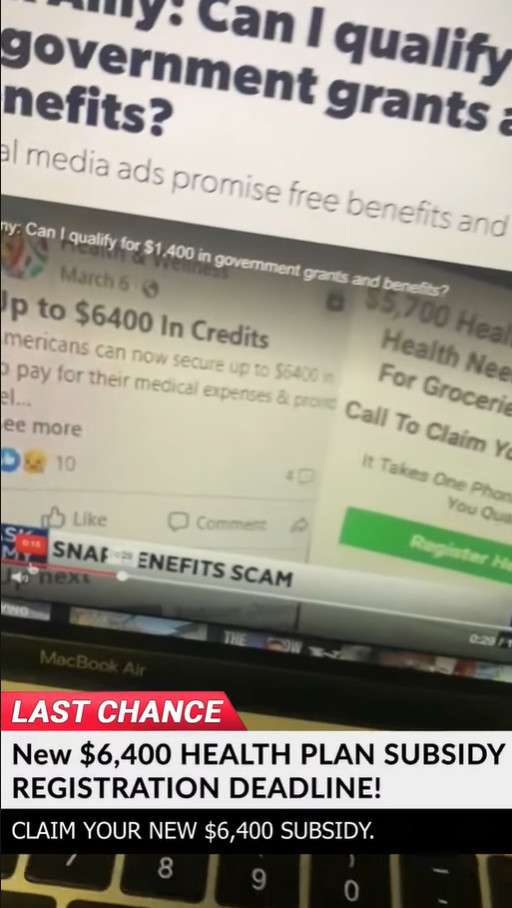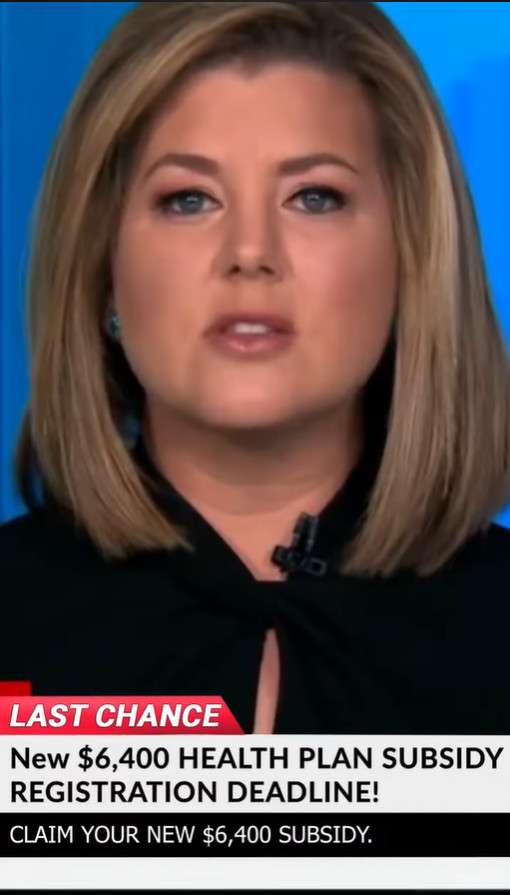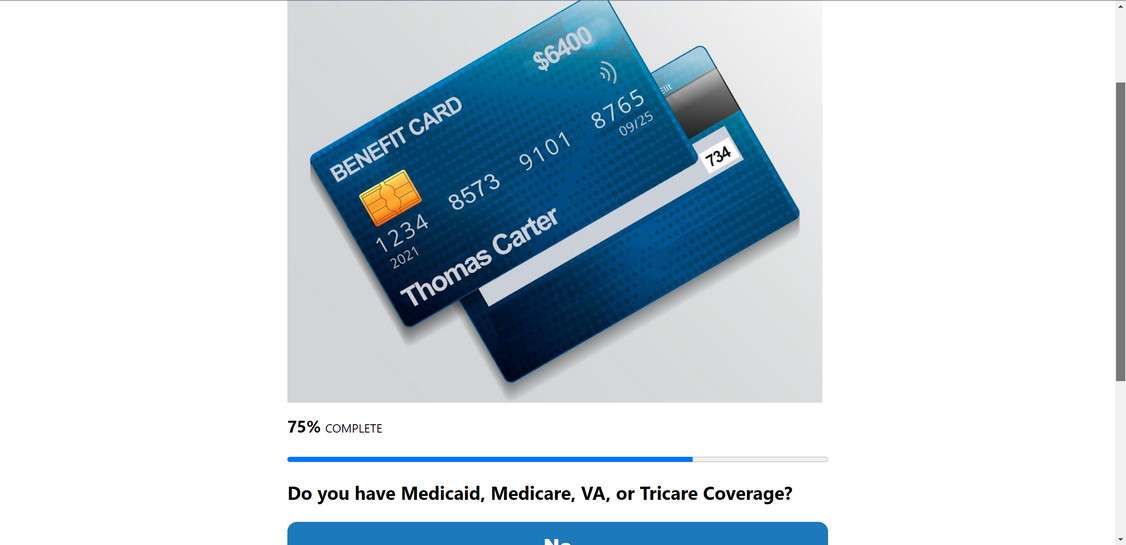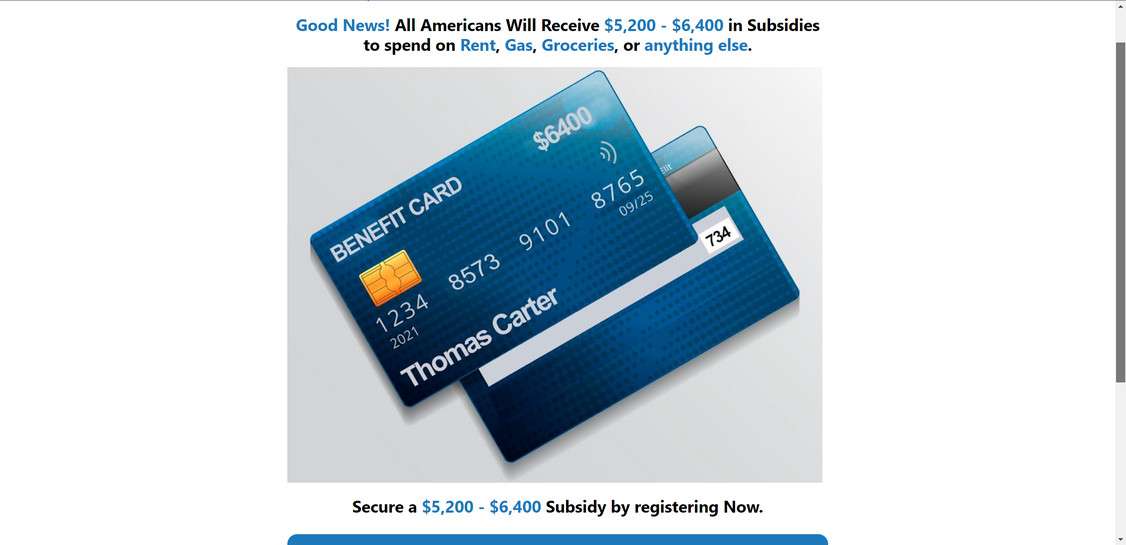A new scam has emerged that is aggressively targeting Americans through robocalls, social media ads, and spam emails. Scammers are claiming that recipients are eligible for a $5,800 subsidy program card, stimulus check, or health benefits card from the government. However, this is a complete scam designed to steal your personal information and money.
This extensive article will provide an in-depth overview of how this subsidy card scam works, what to watch out for, and most importantly, how to protect yourself. With scam tactics becoming more sophisticated, awareness and education are key to avoiding falling victim.





This Article Contains:
Overview of the $5,800 Subsidy Program Card Scam
The $5,800 subsidy program card scam is a new form of imposter scam aggressively targeting Americans through illegal robocalls, scam social media ads, and phishing emails. Criminals behind this scam claim recipients qualify for a special $5,800 government subsidy, stimulus payment, or benefits card. However, the $5,800 subsidy program does not exist and this scam aims to steal your personal information and money.
This extensive scam uses the names “Subsidy Program Card”, “Stimulus Check” or “Health Benefits Card” to convince victims they are receiving money from the government. Scam messages reference the subsidy being worth $5,800, but other amounts like $12,500 or $14,000 may be used. Criminals state these fictional funds can cover any personal expenses like rent, utilities, groceries, car payments, or medical bills.
In reality, the government is not mailing American consumers any such subsidy program cards, stimulus checks, or benefits cards worth thousands of dollars. This scam preys on financial fears during the COVID-19 pandemic. Any message you receive promoting free government money through this fabricated $5,800 subsidy program is 100% fake.
Common mediums scammers use to promote this scam include:
- Illegal Robocalls – Robotexts and robocalls impersonate government agencies like the IRS or Social Security Administration. Calls reference qualifying for a $5,800 health subsidy or stimulus payment. Recipients are prompted to “Press 1” to redeem the fictional funds. Over 59 million scam robocalls were placed to Americans in March 2022 alone.
- Facebook Ads – Paid ads running on Facebook and Instagram feed claim users qualify for a $5,800 COVID health subsidy, stimulus check, or benefits card. Ads include fake celebrity endorsements and AI-generated video clips to appear real. Clicking links goes to phishing sites stealing your info.
- YouTube Scam Ads – Scam ads on YouTube also promote the fake $5,800 stimulus check before playing videos. The ads tout made up COVID relief programs and prompt users to click phony links. This violates YouTube’s terms, but some slip through.
- Spam Emails – Phishing emails sent en masse reference eligibility for a $5,800 health subsidy, stimulus, or benefits card. Emails instruct recipients to call a provided number or click a link to claim the funds, which leads to more scamcalls or data theft sites.
- SMS Text Messages – Fraudulent text messages are being sent informing recipients they qualify for a $5,800 health benefits card, subsidy, or stimulus. The texts instruct them to call a provided phone number to claim the fictional funds.
- Pop-up Browser Ads – Scam pop-up ads appear while browsing claiming you qualify for a $5,800 subsidy program. The notification links to phishing sites aiming to steal login credentials and personal data.
No matter the channel used to reach you, the $5,800 subsidy card scam has the same goal: steal personal information and money from victims. Avoid calling back, clicking links, or providing the scammers any of your information.
Here are some examples of the scam messages you may encounter:
Robocall Message Transcript
“Congratulations! You have been selected to receive a $5,800 health subsidy card from the American Subsidy Program due to COVID-19. This can be used to pay bills, rent, or other household expenses. To claim your $5,800 subsidy, press 1 to speak with a benefits representative.”
Social Media Ad Examples
“COVID Relief Funds: Claim your $5,800 health subsidy card now! You qualify for $5,800 in benefits from the government Health Subsidy Program. Click here to verify your eligibility and claim your health card funds today.”
Phishing Email Example
“Dear,
Our records indicate you qualify for up to $5,800 in stimulus money through the COVID Health Subsidy Program. To receive your health benefits card loaded with $5,800 in funds, please call 1-800-123-4567 today. Claims are time sensitive so call now before this opportunity expires.
Sincerely,
COVID-19 Health Subsidy Department”
As you can see, the scam messages create urgency and excitement around this too-good-to-be-true government subsidy offer. But any message regarding an $5,800 program card, stimulus check, or health benefits card is falsified. Stay vigilant against these scams and warn your family and friends to recognize these tactics.
Regardless of the medium, the goal is the same. Scammers are trying to get personal information and money from victims who believe the government is providing this subsidy. Don’t fall for these tactics.
How the $5,800 Subsidy Program Card Scam Works
Once scammers capture your attention through robocalls, social media, emails, or other methods, they use clever psychological tactics to try tricking victims into participating. Here is exactly how the $5,800 subsidy card scam unfolds:
Step 1: Initial Contact
The first step is making initial contact through one of the mediums outlined above. Most often, this is a robocall or social media ad leveraging the COVID-19 pandemic to make the subsidy offer believable.
The scam call or ad claims you qualify for either a:
- $5,800 Subsidy Program Card
- $5,800 Stimulus Check
- $5,800 Health Benefits Card
- Or some variation thereof
You will be instructed to call or click a link to redeem the offer due to limited funds. The tactics aim to create urgency and excitement around the false promise of $5,800 in government money.
Step 2: Capturing Your Personal Information
Whether you call the robocall back or click the link in a scam email or text, you will be prompted to provide personal information. Common data points requested include:
- Full Name
- Date of Birth
- Mailing Address
- Phone Number
- Email Address
- Social Security Number
This information is used to verify your identity, build trust, and set the trap for the scam that follows.
Step 3: Contact From a “Government Agent”
Within 24 hours, you will be contacted by a scammer claiming to be from the government subsidy program. They confirm your eligibility for $5,800 based on the info provided.
The scammer asks for additional details like:
- Bank account and routing numbers
- Online account login credentials
- Credit card information
This information is supposedly needed to deposit the $5,800 into your bank account or confirm your identity. In reality, it is used to steal your money and commit identity theft.
Step 4: Remote Access to Your Device
The scammer will claim the $5,800 can only be deposited directly through the Federal Reserve. To verify your identity and eligibility, they must remotely access your computer or smartphone.
If you allow remote access, the scammer can now install malware, steal passwords, files, and personal data. They will often manipulate the screen to make it appear the $5,800 was deposited into your bank account.
Step 5: Fake Fees and Taxes
Just as the $5,800 is supposedly deposited, the scammer will claim there are outstanding fees and taxes that must be paid before you can access the funds. These include:
- Processing Fees
- ID Verification Fees
- Benefits Card Activation Fees
- Federal Reserve Bank Taxes
These are all fictional. But victims are tricked into paying hundreds or thousands in supposed “fees” to release the $5,800. Payment is demanded via gift cards, bank wire transfers, Bitcoin, or other difficult-to-trace methods.
Step 6: Cutting Off Contact
Once the scammers receive the fee payments, they cut off all contact with the victim. Phone calls go unanswered, emails bounce back, and texts are ignored. The scammer disappears with the money paid and the victim never receives the promised $5,800 subsidy.
This leaves victims without the promised subsidy money and out hundreds or thousands in fees. It is a devastating double blow to the victim’s finances and sense of security.
How to Spot the $5,800 Subsidy Card Scam
While scammers use sophisticated tactics, there are key signs to spot their $5,800 subsidy card scam attempts:
1. You’re Contacted Out of the Blue
Real government agencies will not call, email, text, or advertise to inform people they are eligible for stimulus funds or subsidy cards. The first red flag is any unsolicited contact claiming you can receive thousands in free government money.
2. They Promise a Specific Dollar Amount
Scammers will tempt victims by naming a high dollar amount like “$5,800” or “$14,000” in subsidy card funds. Real stimulus programs do not promise recipients an exact dollar amount they will receive. Any mention of qualifying for a set amount like $5,800 is a clear scam indicator.
3. Aggressive Call to Action
Scammers create false urgency by saying funds are limited or expiring soon. Their calls-to-action pressure you to act now before losing out on the $5,800, often by calling a provided number immediately. No legitimate agencies force you to take immediate action for stimulus funds.
4. Celebrity Endorsements
Many $5,800 subsidy scam social media ads and robocalls feature celebrities. They use fake quotes or edit celebrities into video endorsements of the phony stimulus program. This deception tactic lures in victims.
5. Verify Personal Information
Before providing any information, research the organization contacting you independently. Most scammers instruct victims to verify personal info to confirm eligibility for the fictional $5,800 subsidy. Never provide sensitive info to unverified people or sources.
6. Can’t Provide Program Details
When pressed for details, scammers can’t explain specifics on the $5,800 subsidy card program, what department manages it, or how to check eligibility without revealing personal data. They intentionally stay vague.
7. Immediate Payment Requested
A huge warning sign is any request for immediate payment via odd methods like gift cards, cryptocurrency, cash reload cards, money wires, or bank deposits. Real government programs do not demand immediate payments from people receiving financial aid or stimulus funds.
Stay alert for these red flags and other suspicious activity. The more aware you are of their tactics, the quicker you can spot the $5,800 subsidy card scam. Don’t become another victim.
What to do if You Fell Victim to the $5,800 Subsidy Card Scam
If you already shared personal information or paid fees to scammers promoting the $5,800 subsidy program card, here are important steps to take:
- Report it – Contact the FTC and FBI to file a report about the scam. Provide as many details as possible. Also alert local law enforcement.
- Dispute unauthorized charges – If scammers accessed your bank account or credit cards, contact those companies immediately to report unauthorized charges. Request chargebacks.
- Change online account passwords – If you shared usernames and passwords, change them all now. Enable two-factor authentication if possible.
- Freeze credit reports – Place freezes on your credit reports to prevent scammers from opening accounts in your name. Visit Equifax, Experian and TransUnion.
- Cancel compromised accounts – Close any accounts that were accessed. Call your bank and credit card companies. Watch for fraudulent charges.
- Install anti-malware software – If scammers accessed your computer remotely, scan for malware and viruses. Remove anything suspicious.
- Beware of recovery scams – Beware any call claiming they can recover lost money for an upfront fee. This is always another scam. Ignore such offers.
- Warn loved ones – Share your experience to help prevent others from falling victim too. Report scam posts on social media to get them removed.
The FTC offers a detailed guide for protecting yourself following an imposter scam and recovering from identity theft. Don’t hesitate to use every resource available to report this scam and regain security.
Frequently Asked Questions About the $5,800 Subsidy Program Card Scam
1. What is the $5,800 Subsidy Program Card scam?
The $5,800 Subsidy Program Card scam is a new form of imposter scam where scammers contact victims claiming they qualify for a $5,800 subsidy program card, stimulus check, or health benefits card from the government. This is completely false. No such program exists. Any message regarding an $5,800 government payout is a scam attempt to steal your personal information and money.
2. How do scammers carry out the $5,800 subsidy card scam?
Scammers use phone calls, emails, social media ads, text messages, and other means to spread this scam. These messages refer to eligibility for a $5,800 subsidy program card, stimulus check, health benefits card, or similar phrasing. Scammers then use psychological tricks and urgent calls-to-action to convince victims to share personal data or pay fraudulent fees to receive the non-existent $5,800 funds.
3. What government agency do scammers impersonate?
Scammers often claim the $5,800 subsidy is being provided by government agencies like the Social Security Administration, Medicare, or COVID-19 relief programs. Some use fictional departments like the “Health Subsidy Program” or “Federal Relief Fund”. No real government agency is offering American consumers $5,800 subsidy cards or stimulus checks.
4. What tactics do scammers use in the $5,800 subsidy scam?
Tactics include fake celebrity endorsements, using victims’ personal info to build trust, claiming limited funds are available, redirecting victims to phishing websites, demanding remote access to devices, and charging fake “taxes and fees” to release the non-existent funds into bank accounts.
5. Is the $5,800 subsidy program card offer real?
No. The $5,800 subsidy program card is a complete scam. The government is not mailing $5,800 stimulus checks or benefits cards to the general public. Any message, call, text, or ad promoting this payout is falsified in order to steal personal information and money from victims.
6. Should I call back or click links about a $5,800 subsidy?
No, you should ignore all calls, emails, texts and social media ads about receiving a $5,800 subsidy program card or stimulus. These messages come from scammers aiming to steal your information. Never call back, click links, or provide the scammers with any personal or financial information.
7. What are signs of the $5,800 subsidy card scam?
Red flags include mention of $5,800 stimulus checks, fake celebrity endorsements, being asked for sensitive information, calls to act immediately, threats of losing funds, requests for remote computer access, demands for gift card payments, suspicious links, and contact from unfamiliar numbers.
8. What should I do if I shared information with $5,800 subsidy scammers?
If you already provided personal or financial information, immediately contact your bank and credit card companies to block unauthorized charges. Change online account passwords, freeze credit reports, scan devices for malware, file reports with the FTC and FBI, and monitor your accounts closely for signs of identity theft.
9. How can I avoid the $5,800 subsidy card scam?
Be wary of unsolicited calls, texts, social media ads, and emails offering government payouts. Never pay fees upfront for financial aid. Legitimate government organizations won’t call requesting remote access to your device. Don’t trust incredibly high dollar offers ($5,800) from unfamiliar sources.
10. How do I report the $5,800 subsidy scam?
If you receive a scam attempt, report it to the Federal Trade Commission and FBI’s Internet Crime Complaint Center. You can also report social media scams to the platform directly. Document details like phone numbers, screenshots, and email addresses to aid investigations.
The Bottom Line
The promise of a $5,800 subsidy program card, stimulus check, or health benefits card from the government is a complete scam. No such program exists. Any call, text, email or ad promoting this is a fraud aiming to steal your money and personal information.
Avoid calling unfamiliar numbers, clicking suspicious links, allowing remote access to your device, or paying any fees upfront. Real government agencies will not call and offer money directly. Report scam attempts immediately and warn others to prevent more victims.
With imposter scams on the rise, awareness of these deceptive tactics is the best defense. Share this article to help more individuals spot and avoid the $5,800 subsidy card scam. Being an informed and vigilant consumer can stop these criminals in their tracks. Don’t become another victim.










